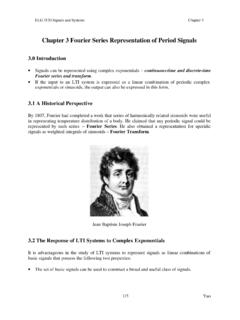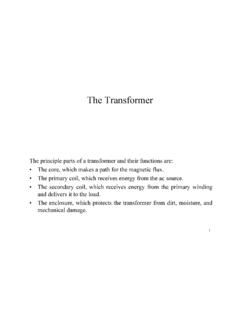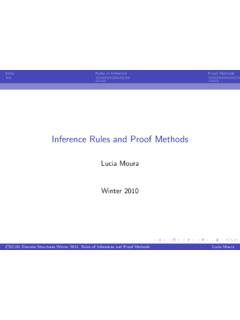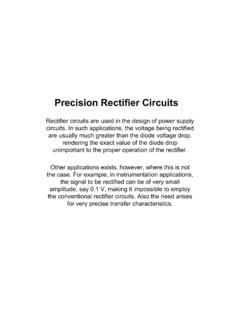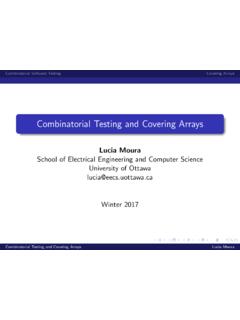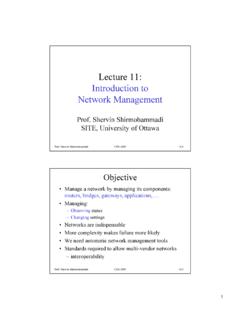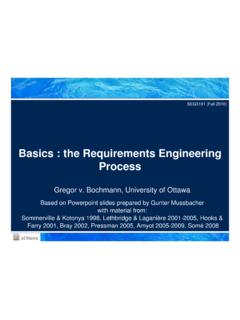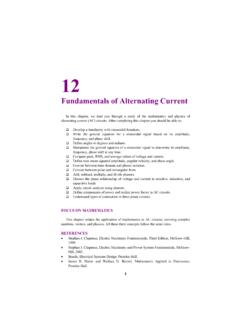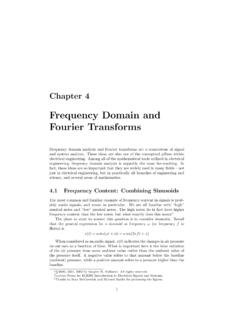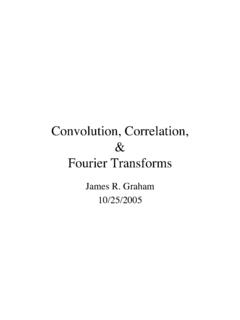Transcription of Chapter 4 Continuous -Time Fourier Transform
1 ELG 3120 Signals and Systems Chapter 4 1/4 Yao Chapter 4 Continuous -Time Fourier Transform Introduction A periodic signal can be represented as linear combination of complex exponentials which are harmonically related. An aperiodic signal can be represented as linear combination of complex exponentials, which are infinitesimally close in frequency. So the representation take the form of an integral rather than a sum In the Fourier series representation, as the period increases the fundamental frequency decreases and the harmonically related components become closer in frequency.
2 As the period becomes infinite, the frequency components form a continuum and the Fourier series becomes an integral. Representation of Aperiodic Signals: The Continuous -Time Fourier Transform Development of the Fourier Transform Representation of an Aperiodic Signal Starting from the Fourier series representation for the Continuous -Time periodic square wave: <<<=2/,0,1)(11 TtTTttx, ( ) 1T1T 2TT2T T T2T2 )(tx The Fourier coefficients ka for this square wave are TkTkak010)sin(2 =. ( ) or alternatively ELG 3120 Signals and Systems Chapter 4 2/4 Yao 0)sin(21 kkTTa==, ( ) where /)sin(21T represent the envelope of kTa When T increases or the fundamental frequency T/20 = decreases, the envelope is sampled with a closer and closer spacing.
3 As T becomes arbitrarily large, the original periodic square wave approaches a rectangular pulse. kTa becomes more and more closely spaced samples of the envelope, as T, the Fourier series coefficients approaches the envelope function. This example illustrates the basic idea behind Fourier s development of a representation for aperiodic signals. Based on this idea, we can derive the Fourier Transform for aperiodic signals. Suppose a signal )(tx with a finite duration, that is, 0)(=tx for 1Tt>, as illustrated in the figure below. From this aperiodic signal, we construct a periodic signal )(~tx, shown in the figure below.
4 ELG 3120 Signals and Systems Chapter 4 3/4 Yao As T, )()(~txtx=, for any infinite value of t. The Fourier series representation of )(~tx is + ==ktjkkeatx0)(~ , ( ) dtetxTaTTtjkk =2/2/0)(~1 . ( ) Since )()(~txtx= for 2/Tt<, and also, since 0)(=tx outside this interval, so we have dtetxTdtetxTatjkTTtjkk ==00)(1)(12/2/ . Define the envelope)( jX of kTa as =dtetxjXtj )()(. ( ) we have for the coefficients ka, )(10 jkXTak= Then )(~tx can be expressed in terms of )( jX, that is 00000)(21)(1)(~ + =+ ===ktjkktjkejkXejkXTtx.
5 ( ) ELG 3120 Signals and Systems Chapter 4 4/4 Yao As T, )()(~txtx= and consequently, Eq. ( ) becomes a representation of )(tx. In addition, 00 as T, and the right-hand side of Eq. ( ) becomes an integral. We have the following Fourier Transform : = dejXtxtj)(21)(TransformFourierInverse ( ) and =dtetxjXtj )()( TransformFourier ( ) Convergence of Fourier Transform If the signal )(tx has finite energy, that is, it is square integrable, < dttx2)(, ( ) Then we guaranteed that )( jX is finite or Eq. ( ) converges. If )()(~)(txtxte =, we have 0)(2= dtte.
6 ( ) An alterative set of conditions that are sufficient to ensure the convergence: Contition1: Over any period, )(tx must be absolutely integrable, that is < dttx)(, ( ) Condition 2: In any finite interval of time, )(tx have a finite number of maxima and minima. Condition 3: In any finite interval of time, there are only a finite number of discontinuities. Furthermore, each of these discontinuities is finite. ELG 3120 Signals and Systems Chapter 4 5/4 Yao Examples of Continuous -Time Fourier Transform Example: consider signal )()(tuetxat =, 0>a. From Eq. ( ), jaejadteejXtjatjat+=+ == + 11)(0)(0, 0>a ( ) If a is complex rather then real, we get the same result if {}0Re>a The Fourier Transform can be plotted in terms of the magnitude and phase, as shown in the figure below.
7 221)( +=ajX, = ajX 1tan)(. ( ) Example: Let taetx =)(, 0>a 2200211)( +=++ =+== aajajadteedteedteejXtjattjattjta The signal and the Fourier Transform are sketched in the figure below. ELG 3120 Signals and Systems Chapter 4 6/4 Yao Example: )()(ttx =. ( ) 1)()(== dtetjXtj . ( ) That is, the impulse has a Fourier Transform consisting of equal contributions at all frequencies. Example: Calculate the Fourier Transform of the rectangular pulse signal > <=11,0,1)(TtTttx. ( ) 1T1T )(tx1 1sin21)()(11 TdtedtetxjXTTtjtj=== . ( ) The Inverse Fourier Transform is = deTtxtj1sin221)( , ( ) Since the signal )(tx is square integrable, 0)( )()(2= = dttxtxte.
8 ( ) )( tx converges to )(tx everywhere except at the discontinuity, 1Tt =, where )( tx converges to , which is the average value of )(tx on both sides of the discontinuity. In addition, the convergence of )( tx to )(tx also exhibits Gibbs phenomenon. Specifically, the integral over a finite-length interval of frequencies WWtjdeT 1sin221 )()(ttx = 1)(= jX ELG 3120 Signals and Systems Chapter 4 7/4 Yao As W, this signal converges to )(tx everywhere, except at the discontinuities. More over, the signal exhibits ripples near the discontinuities. The peak values of these ripples do not decrease as W increases, although the ripples do become compressed toward the discontinuity, and the energy in the ripples converges to zero.
9 Example: Consider the signal whose Fourier Transform is > <=WWjX ,0,1)(. The Inverse Fourier Transform is tWtdetxWWtj sin21)(== . Comparing the results in the preceding example and this example, we have functionSincwaveSquareFTFT 1 This means a square wave in the time domain, its Fourier Transform is a sinc function. However, if the signal in the time domain is a sinc function, then its Fourier Transform is a square wave. This property is referred to as Duality Property. We also note that when the width of )( jX increases, its inverse Fourier Transform )(tx will be compressed. When W, )( jX converges to an impulse.
10 The Transform pair with several different values of W is shown in the figure below. ELG 3120 Signals and Systems Chapter 4 8/4 Yao The Fourier Transform for Periodic Signals The Fourier series representation of the signal )(tx is ==ktjkkeatx0)( . ( ) It s Fourier Transform is )(2)(0 kajXkk = =. ( ) Example: If the Fourier series coefficients for the square wave below are given 1T1T 2TT2T T T2T2 )(tx kTkak 10sin=, ( ) The Fourier Transform of this signal is )(sin2)(010 kkTkjXk = =. ( ) ELG 3120 Signals and Systems Chapter 4 9/4 Yao Example: The Fourier transforms for ttx0sin)( = and ttx0cos)( = are shown in the figure below.
